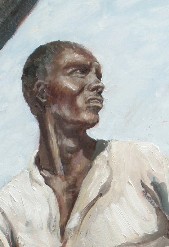
Dhow Crewman
This one is the latest of my series on the Swahili Coast and is inspired by the photos of Allan Villiers, a maritime adventurer and journalist, who spent several months in the 1930s writing and photographing a voyage on one of the last Kuwaiti booms that for centuries had dominated the trade routes between the Arabian Gulf, Somaliland (Somalia), Kenya and Tanganyika (Tanzania). He realised that he was living through the last days of sail and that Arabia was the last place where pure sailing craft carried on as they had for centuries.
This painting was also a turning point for me as I was determined to conquer the challenge of depicting the human form as the main object of the painting.
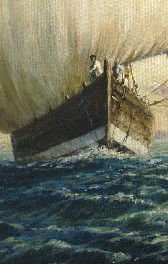
Trading Dhow, Off Zanzibar
This shows one of the large, deep-sea lateen rigged dhows - or booms - that were driven by the trade winds to and from Africa's Indian Ocean coast until the 1970s, when container traffic and Somali pirates finaly did for them. Allan Villiers noted that they needed relatively large crews to manhandle the inefficient gear, especially when it came to tacking. The huge lateen sail was well suited, though, to running before the North-East/South-West trade winds.
The modern fleets, now motorised, can be seen moored beside Dubai Creek unloading raw goods and textiles from India, Pakistan and Iran before returning home loaded with consumer items from the UAE.
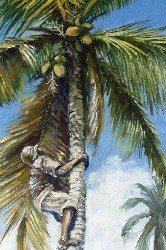
Minasi
One of the greatest pleasures of travelling in Kenya in the heat of the day is drinking refreshing coconut water from the imature madafu, purchased for a few bob from street traders. They make a pleasant change from the usual bottle of 'soda'. This painting is of a farmer shinning up the trunk of one of the coconut palms, minasi, to harvest them, just with the aid of a short length of rope tied between his feet.
Travelling down the coast between Mombasa and Tanga (Tanzania), I saw many plantations of these tall, waving minasi (sing., mnazi), each standing about twenty or more meters high with the undergrowth burnt away beneath and bordered by giant, dark green mango trees. Painting this scene gave me a chance to show the contrasts of the dense greens and yellows of the palm fronds against the intense blue of the tropical sky which, in this part of Africa, just south of the equator, is rarely clear of fair-weather cumulous.
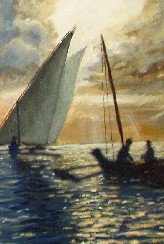
Fishing Dhows, Off the Coast of Pemba
This painting was commissioned, started and finished in a matter of days. In the source image I was attracted by the back-lit early morning sky with the the huge cumulous and high stratus clouds, but I had a real fight with the sea and the dhows. The problem is that photographers often make use filters or "stopping-down" in order to emphasise the sky, but objects at ground level tend to silhouette and consequently loose detail. It can look fine in a photo, but the eye just wouldn't see it that way and normally I dislike paintings that mimic lighting effects that can only be achieved with a camera. On this occasion I didn't have much choice and had to make some compromises, but the client was very pleased with the end result (and that's the main thing!) because he was born and raised in Mombasa. Also it taught me a lot - especially how to work quickly.
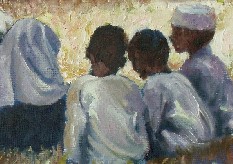
Midday Break, Stone Town
As the title suggests, I captured this image of school children sitting under the shade of a tree in Stone Town, Zanzibar. All the girls were dressed in a smart uniform of navy blue and white and the boys wore the traditional cotton kanzu of varying shades, between white and a subtle pale lilac. The children themselves seemed happier and more content than their counterparts on mainland Kenya.
Zanzibar is famous for its spices, its fabulous climate and wonderful beaches. Stone Town, the capital, has plenty of historic buildings and is relatively clean. If you go off the beaten track, however, you may come across some streets that are lined with hideous, concrete apartment blocks. Apparently they were a gift from the German Democratic Republic, no doubt well intentioned, but they are so shockingly out of place and badly built that they are, ironically, well worth seeing.
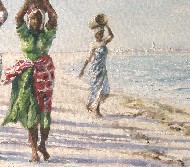
Kutoka Sokoni
This painting was based on an image that for me captured so much of the atmosphere of the East African coast - the dazzling light and heat of the sun, soft coral sand, long violet shadows cast by the palms and a cooling onshore breeze. The title, "Kutoka sokoni", is Swahili for "coming from the market".
The shoreline, fringed with seaweed, leads the eye round the bay to a distant, whitewashed Swahili town. When carrying loads on their heads, there is a natural and attractive elegance to the way the women hold themselves. This is the very best of Africa and I long to be there again whenever I look at this painting.